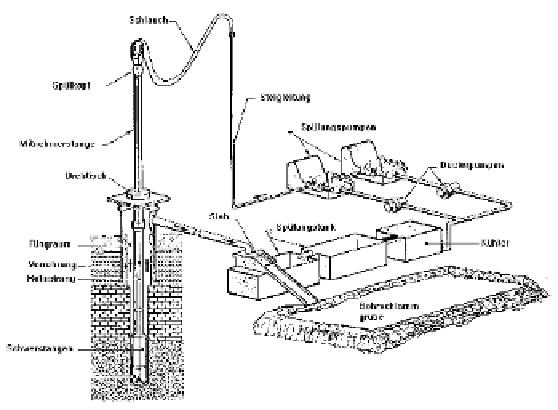Environmental Engineering Reference
In-Depth Information
themselves but due to the costs for the round trip (pulling and lowering of the drill
string) necessary for the replacement of the worn drill bit.
Traditional drilling rigs for depths deeper than 3,000 m are heavy construc-
tions. The height of their tower is in the range of 40 to 60 m. The hook load often
amounts to 600 t. Including tanks, pumps, and pipes for circulating and cleaning
the drilling mud, the ramp and stock area for the drill pipes, containers for per-
sonnel, material, recording units the whole construction covers an area of up to
one hectare. Heavy engines for the mud circulating pumps, for the rotary table,
and the winch for the round trips are required (Fig. 10.2). Their total power
amounts to several MW. The space for the drill site and the noise can become a
severe problem in densely populated areas; for example electrical motors instead
of diesel engines can improve the situation regarding noise.
Mud hose
Swivel
Standpipe
Mud pumps
Kelly
Dosing pump
Rotary table
Shale
shaker
Mud pits
Annulus
Cooler
Casing
Drill pipe
Reserve pit
Drill collar
Bit
Fig. 10.2
The rotary rig and its components /10-2/
The drilling fluid, or mud, is an essential element of the drilling operation. Its
function is not only the transport of the rocks cuttings. Of similar importance is its
ability to stabilise the borehole wall and to prevent the invasion of formation fluid
into the well. Both functions are provided by the pressure resulting from the
weight of the fluid column and require sufficient density of the drilling mud. On
the other hand losses of the drilling fluid in the rock formations have to be mini-
mised. This can be realised by choosing a drilling fluid which builds a mud cake
(thin layer of particles) on the borehole wall as well as by a proper choice of the
density of the drilling fluid. The realised drilling fluid density is therefore a com-
promise and needs careful consideration. It must also consider the possibility of
accidental hydro-fracturing of the rock, resulting in a total loss of the circulation.
Total losses can also happen in highly permeable rock formations, in faults or in
fracture zones. Last but not least the drilling fluid is also needed for cooling of the











Search WWH ::

Custom Search